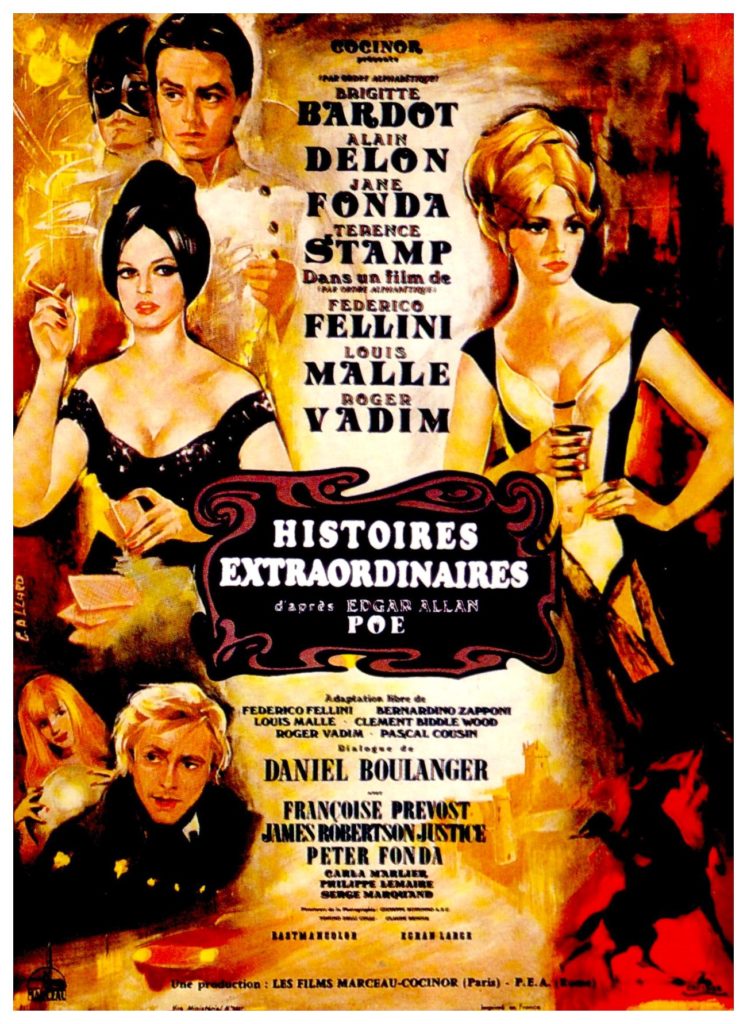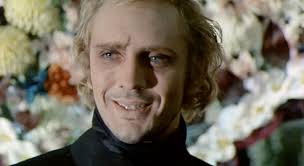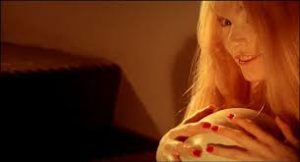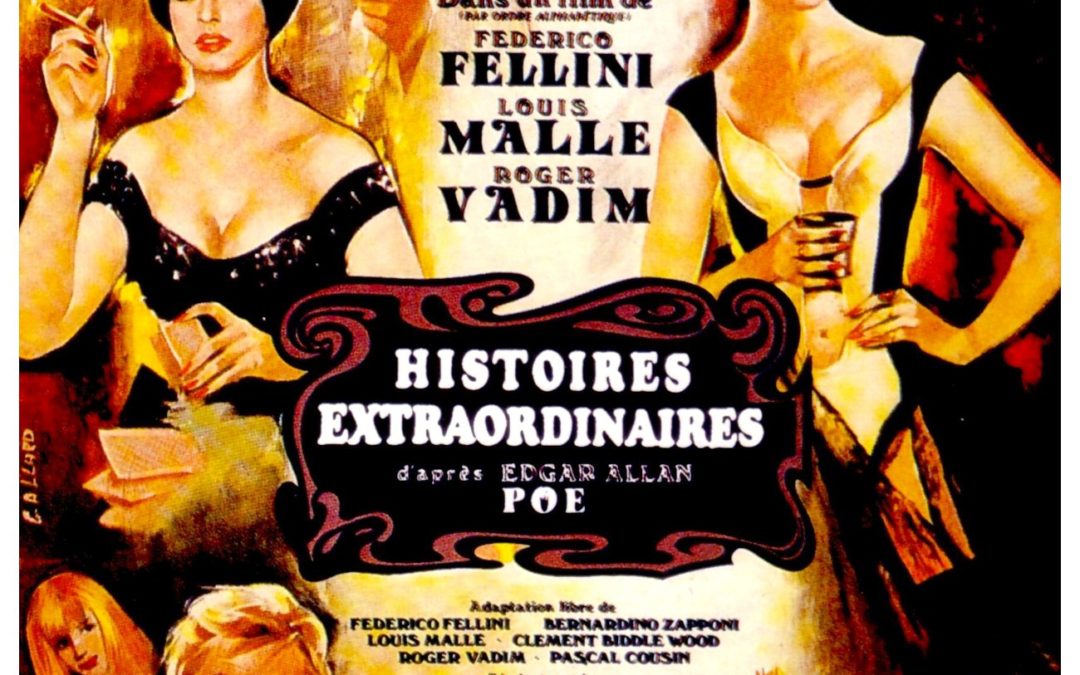TOBY DAMMIT
Alternately hilarious, terrifying and garishly beautiful, Toby Dammit (1968) is the Fellini masterpiece you’ve never heard of — the last full flowering of a protean genius’s most fully realized cinematic period.
It’s also a film that wouldn’t exist if schlockmeister Roger Corman hadn’t made a series of variable but ambitious Edgar Allan Poe movies for American International Pictures, starring the ultimate movie hambone, Vincent Price.
Commenced in 1960 and spanning about a decade of production, the AIP Poe Cycle created runaway hits by the standards of B-moviedom, in part because it featured A-minus level production values, including period costumes and color cinematography by the likes of Nicholas Roeg. Corman’s Masque of the Red Death is probably the best of the bunch if
you like trippy 60s decor; Pit and the Pendulum is the scariest, along with The Premature Burial — an independent production Corman mounted starring AIP regular Ray Milland when Price proved unavailable.
But by far the most stylish film to come out of the Poe cycle is a distant adjunct: Fellini’s Toby Dammit, created as one segment of an international Poe omnibus film that was actually distributed by AIP in America, with the characteristic addition of a deliciously over-ripe linking narration from Price.
The anthology film in question was called Spirits of the Dead, and its other two Poe installments — Metzengerstein, directed by Roger Vadim, and William Wilson by Louis Malle, both have their fans, though I personally find them both unrelievedly dull. Aside from the icky coup of casting his then wife Jane Fonda opposite her brother Peter as the love interest, Vadim’s piece in particular is just flat out un-cinematic — poorly paced, badly framed, somnambulistically performed. Malle’s is just boringly proficient. Which is actually kind of worse.

Spirits of the Dead European onesheet
Fellini’s film on the other hand is a majestic, despairing and entirely achieved work, and a fitting companion piece to 8 1/2 and
Juliet of the Spirits, the twin masterpieces that preceded it.
In the very autobiographical 8 1/2, Fellini had created a new visual language designed to reflect the streams of consciousness — the movement between reverie and reality — of his own overactive mind. Surreal, circus-like and widely imitated, 8 1/2 is the source for such other cinematic autobiographies as Paul Mazursky’s Alex in Wonderland (and The Pickle, Mazursky’s unfairly maligned final film); Bob Fosse’s All That Jazz and Woody Allen’s Stardust Memories. Ken Russell must have seen 8 1/2 and been struck as if by the hand of God — almost every film he made once he became a “name” director derives from what can only be thought of as a misunderstanding of Fellini’s approach, which Russell seems to have taken as a license to put pretty much anything he could think of up on the screen. And don’t get me started on Nine of 8 1/2 Women.
With Juliet of the Spirits, Fellini applied his carnivalesque new cinematic language to a portrait of the woman he new best: his wife Giulietta Masini, with brilliant if at times overwrought results. In a sense, Juliet is an experiment, and a transitional work, asking the question: Could such a private language, so wedded to the way Fellini himself thought and felt, be tied to a portrait of someone else?

Terence Stamp as Toby Orpheus in Night Town
With Toby Dammit, Fellini answers that query with a resounding “Yes” by creating an entirely fictional character (one whose struggle has nothing to do with Poe) and building a visual masterwork around him. Toby, played rivetingly by Terence Stamp in what is easily the best English-language performance in any Fellini movie, is an actor in crisis, being eaten alive by his tumorous self contempt. He’s come to Rome for a satirical reason, made all the more hilarious because it’s imaginable if not plausible: he is to star in a Spaghetti Western based on the life of Christ.
But Toby is also an unmitigated drunk on his last bender, haunted by a strange vision of the devil as a little girl (it would be interesting to uncover whether or not Spirits was widely seen in Japan, because this character, played by Russian actress Marina Yaru could have come straight from any number of Japanese ghost stories, including The Ring). Hellbent on self destruction, Toby must first drift like a ranting Orpheus through a purgatorial underworld of sycophants and celebrity driven trivia. When death comes for him, he seems to welcome it with giddy joy.

Marina Yaru as the devil that haunts Toby
The concerns are classic Fellini, from the dissolute and self-destructive protagonist to the vibrant but vapid and soul crushing milieu. And the cinematography — by Fellini’s frequent collaborator Guiseppi Rotunno — is as ravishing and surreal as anything
ever committed to film. The camera prowls and swoops in a nightmare world of reds and blacks and golds. The frame overflows with grotesques engaged in half heard conversations, surreal images on TV screens, cartoonish backgrounds made of models and projections.
No other director has ever created such vivid depictions of entropy. Fellini remains the cinema’s great master of kinetic ennui.
Because it exists as one third of an otherwise undistinguished movie of foreign origins, Toby Dammit has gone virtually unseen in America. But the forty minute running time in fact makes Toby Dammit an ideal point of entry for a viewer unfamiliar with Fellini — it’s like a brilliant short story by Conrad, containing his highest level of technique and his greatest thematic preoccupations, all sharpened down to a feverish point where nothing extraneous is observable.
It’s also scary as hell, in a way that bypasses the jump scare for something approaching terminal dread. Toby Dammit is a thinking person’s Halloween treat. Just don’t be surprised if it haunts you long after the holiday ends.

